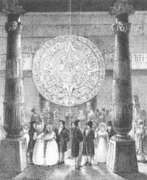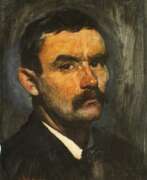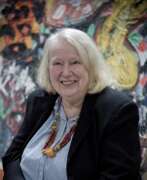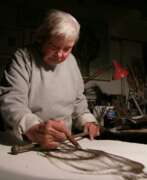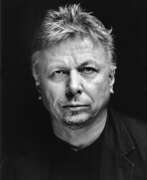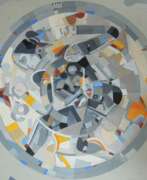Engravers 20th century


Jenny Fikentscher (born Nottebohm) was a German painter and graphic artist associated with the Art Nouveau movement. She studied at the School of Women Painters in Karlsruhe and later became part of the Grötzingen artist colony. Fikentscher married animal painter Otto Fikentscher and raised five children in an unconventional artistic household. She was known for her botanical motifs and lithographs, often featuring local plants. Fikentscher also created collectible images for the Stollwerck chocolate company.


Jan Leth Aagensen was a Danish artist. He made his name as a lithographer and later became known for his sculptures.
Jan Leth's formal training took place at the Royal Danish Academy of Fine Arts under Professor Søren Hjort Nielsen from 1965 to 1969. His first exhibition took place in 1961 at Kunstnernes Forårudstilling (Spring Artists' Exhibition). He is a member of various art groups: Decembristerne, Kunstnersamfundet og Foreningen Danske Grafikere, the Association of the Royal Danish Academy of Fine Arts and the Association of Danish Painters Engravers.
Jan Leth has participated in various solo and group exhibitions, presenting paintings, sculptures, drawings, and installations in Denmark and abroad. He has received many honours and grants throughout his life. The Danish State gave him a lifelong economic grant in 1998. His work is represented in gallery collections in Denmark and internationally.


Louise Abbéma was a French painter, sculptor, and designer, celebrated for her work during the Belle Époque. Born in Étampes in 1853 into an affluent Parisian family, she became well known for her portraits, particularly of the famous actress Sarah Bernhardt, and for decorative panels commissioned for various public buildings in Paris and the Palace of the Governor in Dakar, Senegal.
Abbéma's art often depicted the upper echelons of French society and reflected the Impressionist style through her light and rapid brushstrokes. She was also notable for her involvement in the women's movement, where she contributed to the emerging image of the 'New Woman' by portraying androgynous figures and themes of intellectualism and freedom.
Among her many honors, Abbéma was awarded the Palme Academiques in 1887, nominated as the Official Painter of the Third Republic, and in 1906, she became a Chevalier of the Legion of Honour. Her works, such as "Lunch in the Greenhouse" and "Portrait of Sarah Bernhardt," have seen a resurgence in popularity as the contribution of women to historical art gains more recognition.
For those interested in the evocative and historically rich artworks of Louise Abbéma, consider subscribing to our updates. We'll keep you informed about new sales, auctions, and exhibitions featuring Abbéma's work, ensuring you're always connected to the latest offerings in the art and antique collectors' sphere.


Peter Ackermann was a German painter and graphic artist. He became known for his alienation of architectural subjects. Ackermann was a representative of fantastic realism. The preferred subject of his work was classical Italian architecture, which he drew on site. He put together columns, portals and walls with machine parts, ruins and desolate parts of the city, which were piled up threateningly and thus alienated. In his etchings he showed references to the techniques of the old masters, his pictorial conception is compared with that of Giovanni Battista Piranesi and Canaletto.


Franz Ackermann is a German media artist.
He studied at the Academy of Fine Arts in Munich and at the University of Fine Arts in Hamburg, lives and works in Berlin and Karlsruhe.
Franz Ackermann's work includes drawings, watercolors, murals, paintings and installations, which he complements with photographic works, projections and architectural models. His works deal with the themes of tourism, globalization and urbanism and reflect the social changes and political problems caused by increasing globalization.


Henri-Georges Adam was a French engraver and non-figurative sculptor of the École de Paris, who was also involved in the creation of numerous monumental tapestries. His work in these three areas is regarded as among the most extensive of the twentieth century.


Giuseppe Ajmone was an Italian painter and printmaker.
He studied painting at the Brera Academy of Fine Arts in Milan and in 1946 was one of the signatories of the Realist Manifesto, also known as "Oltre Guernica.
Ajmone painted both landscapes and still lifes as well as semi-abstract figures.


Luis M. Alonzo-Barkigia is a contemporary Mexican artist. He studied at the Malmö Academy of Art (Sweden) and at the University of Illinois at Chicago. He was awarded the UIC Presidential Fellowship, the Larsen Fellowship for Studio Arts.




Charles Arnoldi is an American painter, sculptor and printmaker.
In the early 1970s, the artist attracted attention for his wall-relief wood sculptures, such as Honeymoons in the collection of the Honolulu Museum of Art.
The use of wood remained a feature of Arnoldi's oeuvre, although, since the 1980s, he has often employed it in combination with other media. In the 1990s, Arnoldi's output changed radically. He began producing abstract paintings on canvas, first black and white, and later brightly colored.


Gerd Arntz was a 20th-century German artist known for his skillful woodcut prints. A member of the Cologne Progressives—a group concerned not just with social and political issues, but also with the public’s ability to understand these concepts—Arntz sought to use his art as a method of delivering crucial information to the masses. Over the course of his life, he designed approximately 4,000 pictograms known as ISOTYPEs, or International System of Typographic Picture Education, a unique form of symbolized data from industries, politics, and economic phenomena intended for use by those who could not read.


Maurice Paul Jean Asselin was a French painter, watercolourist, printmaker, lithographer, engraver and illustrator, associated with the School of Paris. He is best known for still lifes and nudes. Other recurring themes in his work are motherhood, and the landscapes and seascapes of Brittany. He also worked as a book illustrator, particularly in the 1920s. His personal style was characterised by subdued colours, sensitive brushwork and a strong sense of composition and design.
He was awarded the rank of Officier de la Légion d'honneur in 1939.


Ugo Attardi was an Italian painter, sculptor and writer. Attardi moved from Genoa to Rome in the early 1950s, where he formed the group Forma 1 together with other artists. His sculpture of Ulysses is now permanently installed in Battery Park in New York


Daniel Authouart is a French painter, draughtsman and lithographer.
He studied at the École des Beaux-Arts in Rouen and lives and works in the same city. Authouart is known for his hyper-realistic paintings and lithographs on themes of modern life. He also created book bindings, posters and theater sets.


Belkis Ayón was a Cuban printmaker who specialized in the technique of collography. Ayón created large, highly-detailed allegorical collographs based on Abakuá, a secret, all-male Afro-Cuban society. Her work is often in black and white, consisting of ghost-white figures with oblong heads and empty, almond-shaped eyes, set against dark, patterned backgrounds.


Aino Bach (Russian: Айно Густавовна Бах) was an Estonian and Soviet artist of the twentieth century. She is known as a painter, graphic artist and printmaker.
Aino Bach was one of the first Estonian printmakers to demonstrate mastery of the intaglio technique, which expanded the possibilities of engraving. Her work includes portraits, genre compositions and illustrations. She employed a variety of techniques including gravure printing, metal engraving, and color monotype. Her works often combined different techniques, giving them a distinctive flavor.


Bele Bachem (real name Renate Gabriele Bachem) was a German painter, graphic designer, book illustrator, interior designer and writer. In 1997 Bachem was awarded the Order of Merit of the Federal Republic of Germany.
Bachem is considered one of the most important post-war German artists and one of the few surrealists in the illustration of German literature.


Albert Baertsoen was a Belgian painter, pastellist and graphic artist. His debut as a painter came in 1887, when he participated in an exhibition in Brussels held by the secessionist group l'Essor. He continued his studies in Paris, at the art school of Alfred Philippe Roll, and exhibited at the Salon in 1889. In 1894, he helped found the "Cercle des Beaux-Arts d'Ostende". From 1896 to 1901, he continued to exhibit throughout Europe, winning several Gold Medals. In 1913, he served as a member of the art jury for the Ghent World's Fair. During World War I, he lived in London, returning to Ghent in 1919. That same year, he was appointed a member of the Royal Academy of Belgium.


Ethel Barringer was a South Australian artist who excelled in various media, but was particularly known for her etchings. She was educated at the Advanced School for Girls under Miss Rees George, and was a student of Hans Heysen and Mary Packer Harris at the SA School of Arts and Crafts. She studied in London for several years and took courses in enamelling, jewellery designing, life work, and etching at the St John's Wood Art School and the Sir John Cass Technical School. On her return to Adelaide she set up a studio of her own in Flinders Street, but gave it up when she gained an appointment as assistant teacher at the School of Arts and Crafts on North Terrace.


Constantin Ludwig Bauer was a German painter. Numerous landscape watercolors come from Bauer. Bauer studied from 1869 to 1873 at the Academy of Fine Arts in Munich. He learned figure painting from Alexander Wagner and copperplate engraving from Johann Leonhard Raab. In 1878 Bauer moved to Obermais (South Tyrol). There he devoted himself to landscape painting.
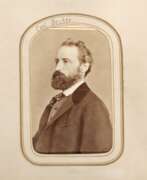

Carl Emil Rudolf Ludwig Becker was a German marine artist.
He was awarded gold medals at the International Art Exhibition of 1894, in Vienna, and the Große Berliner Kunstausstellung of 1896. Three years later, he was one of the co-founders of the Düsseldorfer Künstler-Vereinigung (artists' association). After the turn of the century, marine painting was heavily promoted by Kaiser Wilhelm II, who was attempting to make Germany a major sea power. As a result, the demand for Becker's paintings increased farther inland.


Peter Becker is a German landscape painter, engraver, and lithographer. In his many landscape works he romanticizes the German forest and enlivens it with historical characters. He also painted genre scenes and depicted city streets.


Tayeba Begum Lipi is a Bangladeshi artist and the co-founder and trustee of Britto Arts Trust. She has received Grand Prize at the 11th Asian Art Biennale, Bangladesh 2004. Lipi is a multimedia artist who has engaged in paintings, prints, installations and videos. Her works have been featured in notable group exhibitions, including the 54th Venice Biennale (2011) and Colombo Art Biennale (2012). She was also the commissioner for the Bangladesh Pavilion at the 54th Venice Biennale (2011).


George Wesley Bellows was an American realist painter, renowned for his vivid portrayals of urban life in New York City. Born on August 12, 1882, in Columbus, Ohio, Bellows moved to New York in 1904, where he became a central figure in the Ashcan School of painting. This group was known for its realistic and often gritty depictions of everyday city life. Bellows captured dynamic scenes ranging from boxing matches to bustling street views, applying vigorous brushwork that conveyed movement and emotion.
One of Bellows' most celebrated series was his boxing paintings like "Stag at Sharkey’s," which encapsulate the raw, dynamic energy of illegal prizefights in early 20th-century New York. Beyond the ring, his works such as "New York" and "Pennsylvania Excavation" reflected the rapid transformations of urban landscapes. His adaptation of lithography also marked a significant contribution to American art, offering a new medium for expressive possibilities.
Bellows' art is preserved in major institutions such as the Metropolitan Museum of Art and the Museum of Modern Art in New York. His ability to depict the vibrancy and complexity of urban life makes his work a valuable part of American art history.
For updates on exhibitions and available works of George Wesley Bellows, consider subscribing to our newsletter. This subscription will keep you informed about new sales and auction events specifically related to Bellows' art.


Alois Bergmann-Franken was an academically trained German painter. In the 1930s he began to become known in the Franconian region through his artistic work in the churches. He mastered the fresco technique, encaustic painting, tempera painting and oil painting. By 1965, he had created over 40 depictions of the Way of the Cross in paintings and mosaics, many frescoes and mosaics in churches in Lower Franconia, oil paintings, watercolours, concrete glass windows, woodcuts and sculptures of the Madonna.


Siegfried Berndt, born 1880 in Germany and passing away in 1946, was a distinguished painter and printmaker whose artistic contributions are often overlooked in art history. After studying at the Dresden Art Academy, Berndt received a travel scholarship that profoundly influenced his art, taking him to cities like Paris, Brussels, Antwerp, London, and Scotland. These travels exposed him to diverse artistic movements, enriching his work with elements of Impressionism, Expressionism, and New Objectivity.
Berndt was especially skilled in the traditional Japanese woodblock printmaking technique, which he employed to explore various artistic styles. This unique approach resulted in color woodcuts with a distinct personality, appealing to a wide range of collectors. His woodblock prints are particularly noted for their innovative use of this traditional technique, blending it with Western artistic movements.
Despite the challenges posed by the two World Wars, Berndt's work found its way into public collections and was recognized for its artistic merit. However, much of his pictorial work was lost due to the turmoil of war. Some of his expressive pastel works, often repeated with small variations, as well as oil paintings, have been documented.
Berndt's art remains relevant for collectors, auctioneers, and experts in art and antiques, particularly for those interested in the intersection of Eastern and Western printmaking techniques. His work, although not as widely known, represents a unique blend of styles and techniques that contribute to the rich tapestry of early 20th-century art.
For enthusiasts interested in staying updated about sales and auction events related to Siegfried Berndt's work, subscribing to updates would be beneficial. This ensures access to the latest information about new sales and auction events related to his art.


Etienne Prosper Berne-Bellecour was a French artist. He was a painter, illustrator, and engraver who specialized in military scenes, battlefields, and portraits of soldiers. He is considered one of the most important French artists of the 19th century.
Berne-Bellecour began his career as an illustrator for French newspapers and magazines. He later became a painter, and in 1863 he exhibited his first painting at the Salon in Paris. In 1873, he became a member of the Académie des Beaux-Arts.
Berne-Bellecour was known for his highly detailed and realistic paintings of military life. He often depicted battle scenes with soldiers in uniform, and his attention to detail was highly admired. He was also known for his portraits of military leaders, including Napoleon III and Marshal MacMahon.
Berne-Bellecour continued to paint and exhibit his work throughout his life.


Virginia Berresford is an American artist and printmaker.
Virginia Berresford studied with George Bridgman at the Art Students' League and in Paris with Amedee Ozenfan from 1925 to 1930. Berresford was known for her landscape paintings with strong composition and use of colour as well as attention to detail.
In the 1950s she opened an art gallery in Edgartown, Martha's Vineyard. Her work is included in the permanent collections of the Whitney Museum of American Art, the Detroit Art Institute and the Dallas Museum of Art.


Edmond Bille was a Swiss artist. Bille engaged in intense and varied activity as painter, engraver, stained glass artist, journalist, writer, and politician. He is the creator of the stained glass windows around the altar of the Cathedral of Lausanne, capital of the Swiss canton of Vaud.


Pierre Bonnard was a distinguished French painter and printmaker, recognized as one of the foremost colorists of modern art. Born on October 3, 1867, in Fontenay-aux-Roses, France, Bonnard initially pursued law studies before embracing his true calling in art. He attended the École des Beaux-Arts and the Académie Julian, where his journey as an artist began in earnest.
Bonnard's art is characterized by its vibrant use of color and the portrayal of intimate, sunlit domestic interiors and gardens. His works often include scenes populated with friends and family, creating a narrative that is both personal and relatable. His distinctive style was influenced by Japanese prints, evident in his use of bold patterns and flat color planes. This influence earned him the nickname "Le Nabi très japonard" among his peers in the Les Nabis group, an avant-garde artists' group he joined in his twenties.
His early work, such as "Woman in Checkered Dress" (1890), showcases the influence of Japanese prints. Bonnard's talent was evident from the beginning of his career, with Claude Roger-Marx noting in 1893 his ability to capture fleeting poses and expressions. His work evolved over time, moving towards a style that resonated with the Intimists' focus on personal and intimate spaces.
Bonnard's wife, Marthe, was a recurring subject in his paintings, often depicted in everyday scenarios. Their relationship, spanning several decades, was a significant influence on his work. His paintings, such as "Dining Room on the Garden" and "Landscape at Le Cannet," demonstrate his mastery in capturing light and color, creating a sense of warmth and intimacy.
Bonnard's work remains influential and celebrated, with his paintings held in esteemed collections worldwide. His ability to transform everyday scenes into vibrant, color-filled canvases has made him a beloved figure in the world of modern art.
Art collectors and experts in the field will find Bonnard's work a study in the transformative power of color and composition. For those interested in staying updated on sales and auction events related to Pierre Bonnard's works, signing up for updates would provide valuable insights into this remarkable artist's enduring legacy.


Jonathan Borofsky is an American artist known for his public sculptures and installations that explore themes of human consciousness, individuality, and interconnectedness.
Borofsky studied at Carnegie Mellon University and Yale University. In the 1970s, he gained recognition for his conceptual and performance works, which often incorporated elements of language, text, and repetition.
In the 1980s, Borofsky began creating large-scale public sculptures, many of which feature human figures or silhouettes. One of his most famous works is "Molecule Man," a 100-foot-tall sculpture of three interconnected figures located in Berlin, Germany.
Borofsky's work has been exhibited in major museums and galleries around the world, including the Museum of Modern Art in New York, the Centre Georges Pompidou in Paris, and the National Museum of Contemporary Art in Seoul. He has also created public artworks in cities such as New York, Tokyo, and Tel Aviv.
In addition to his art, Borofsky is known for his interest in meditation and spirituality, which he often incorporates into his work. He has published several books on these topics.
Borofsky continues to live and work in Ogunquit, Maine, where he maintains a studio and creates new works of art.


Jean-Louis Boussingault was a French painter, printmaker and illustrator, and designer.
Boussingault studied at the Académie Julian and socialized closely with the student artists of that academy. He first exhibited in 1909 at the Salon des Indépendants. In 1919 he joined the Compagnie des arts français, founded by the architect and decorator Louis Xue and the designer André Marais. In addition to painting, he practiced dry needling, etching and lithography.


Arthur Merric Boyd was an Australian painter. He and his wife Emma Minnie (née à Beckett) established a lifestyle of being artists which many generations followed to create the popular image of the Boyd family. Boyd travelled and painted a good deal on the continent of Europe, and returned to Australia about the end of 1893, where he lived mostly in Sandringham and other suburbs of Melbourne for the rest of his life. He occasionally sent good work to the exhibitions of the Victorian Artists' Society, but never mixed much in the artistic life of his time.


Félix Bracquemond was a French painter, etcher, and printmaker. He played a key role in the revival of printmaking, encouraging artists such as Édouard Manet, Edgar Degas and Camille Pissarro to use this technique.
Unusually for a prominent artist of this period, he also designed pottery for a number of French factories, in an innovative style that marks the beginning of Japonisme in France.


Yves Brayer was a French painter and lithographer known for his landscapes, portraits and still lifes.
Brayer studied at the École Nationale Supérieure des Beaux-Arts in Paris and then in Rome. He was influenced by classical art and inspired by Mediterranean landscapes, which he often depicted in his paintings. He was also interested in the culture of ancient Greece, which influenced his work.
Brye's early work was inspired by the Cubist and Surrealist movements. He was a founding member of the Paris School, a group of artists working in the French capital in the mid-twentieth century. He was also a member of the French Academy of Fine Arts and a Knight of the Legion of Honour.
Bryeux's work has been exhibited in prestigious galleries and museums around the world, including the Louvre in Paris, the Museum of Modern Art in New York and the National Museum of Western Art in Tokyo. His paintings are in many private collections.
Over the course of his career, Brye has received numerous awards and honours, including the Grand Prix de Rome and the Prix de l'Institut de France. He is considered one of the most important French artists of the 20th century.


Osip Emmanuilovich Braz (Russian: Осип Эммануилович Браз) was a Russian-Jewish realist painter, celebrated for his adeptness in portraying the subtleties of human character and the serene beauty of landscapes. Born in Odessa in 1873, Braz embarked on his artistic journey at the Odessa Art School, later honing his craft in Munich under the guidance of Sandor Kholloshi and in St. Petersburg at the Academy of Arts, where he studied under the legendary Ilya Repin. His early works, marked by a series of compelling portraits, including those of eminent Russian cultural figures like Anton Chekhov, garnered him significant acclaim. Braz's portrait of Chekhov, commissioned by Pavel Tretyakov for the State Tretyakov Gallery, is particularly noted for being the only complete lifetime portrait of the writer.
Braz's contributions to art were not confined to portraiture alone; he also produced exquisite still lifes and landscapes, capturing the essence of his subjects with a delicacy and depth that reflected his mastery over the medium. His landscapes of France, Crimea, and Finland, inspired by his travels, exhibit a remarkable sense of place and mood, blending realism with an impressionistic sensitivity to light and color.
Throughout his career, Braz was deeply involved in the art community, participating in the World of Art exhibitions and influencing the artistic dialogue of his time. Despite facing adversity, including imprisonment and the confiscation of his art collections by Soviet authorities, Braz's legacy as a painter and collector endures. His works continue to be celebrated for their technical prowess and emotional depth, held in high esteem by collectors and experts alike.
For collectors and experts in art and antiques, Osip Emmanuilovich Braz's oeuvre offers a window into the soul of Russian realism and the broader currents of European art at the turn of the century. His life's work underscores the enduring power of art to capture the human condition and the natural world in all their complexity and beauty. Sign up for updates to stay informed about new product sales and auction events related to Osip Emmanuilovich Braz and delve deeper into the legacy of this remarkable artist.


Gerald Leslie Brockhurst was a British painter and etcher.
During the 1930s and 1940s he was celebrated as a portraitist, painting society figures such as Marlene Dietrich and the Duchess of Windsor. Today he is best known for his small etched prints of beautiful, idealized women — many of them modelled by his first and second wives.


Jason Brooks is a contemporary British artist known for his fashion illustrations and portraits. He was born in 1969 and studied at Chelsea School of Art and Central Saint Martins in London. His work has been published in publications such as Vogue, Elle and The New Yorker.
Jason Brooks has worked with fashion brands including Chanel, L'Oreal and Christian Dior. As well as commercial work, he has exhibited his work in galleries around the world, including the Saatchi Gallery in London and the Museum of Modern Art in Tokyo.




James Brown was an American-born painter active in Paris and Oaxaca, Mexico. He was most well known in the 1980s for his rough painterly semi-figurative paintings, bearing affinities to Jean-Michel Basquiat and East Village painting of the time, but with influences from primitive art and classical Western modernism. His work has taken on several styles over the years but maintains a hand-made look combining concerns of the modernist tradition with motifs and spiritual interests from tribal art. Much of his work is a non-realistic but contains depictions or signs of recognizable faces or objects. However, the line between representation and abstraction is often a difficult one in his work. Besides paintings Brown has also produced sculptures and series of prints at various points in his career, and in the 1990s started to heavily utilize collage.




Karel Brož (Russian: Карл Осипович Брож) was a Czech and Russian artist, renowned for his detailed illustrations and watercolors. Born on November 25, 1836, in Prague, he studied at the Vienna Academy of Fine Arts and later moved to Russia, where he became a prominent illustrator for various publications, including "Vsemirnaya Illustratsiya."
Brož's work is characterized by its meticulous attention to detail and vibrant depictions of historical and everyday scenes. His illustrations, particularly for Russian periodicals, captured the essence of 19th-century life and remain highly regarded in art circles.
Collectors value Brož's pieces for their historical significance and artistic quality. His illustrations have been featured in numerous exhibitions and are part of prestigious collections. For those interested in historical illustrations, Karel Brož’s work offers a unique glimpse into the past.
Sign up for updates on new product sales and auction events related to Karel Brož to stay informed about the latest opportunities to acquire his work.


Anselmo Bucci was an Italian painter, printmaker, writer and one of the founders of the Neoclassical trend in Italian art in the early 20th century, the Novecento.
Anselmo Bucci studied painting in Venice and the Brera Academy in Milan. From 1906 to 1914, he lived in Paris where he joined the Groupe libre, a group of artists who accepted a departure from academic canons, but did not share the ideas of avant-gardism.
Anselmo Bucci is a modernist painter, symbolist with strong Fauvist features. Created a number of monumental works, as well as small paintings of a lyrical nature.
Along with painting, he was actively engaged in literary activities. In 1930 he was one of the first recipients of the prestigious Viareggio literary prize.


Bernard Buffet was a French artist renowned for his distinctive style of painting, printmaking, and sculpture. His work, characterized by expressive, angular lines and somber themes, has captivated collectors and art enthusiasts worldwide. Buffet's art, deeply influenced by the post-war period in France, reflects themes of despair, loneliness, and the human condition, often portrayed through his iconic clowns and desolate landscapes. His approach to art, marked by stark compositions and a vivid portrayal of existential angst, positioned him as a leading figure in the modern expressionist movement.
Buffet's career was meteoric from its onset; by his early twenties, he was celebrated alongside cultural icons of the time, earning him a spot among the "Fabulous Five" of post-war France. Despite his early acclaim, Buffet's later years were marked by controversy and a decline in popularity, as shifts in artistic trends and criticism over his lifestyle choices overshadowed his contributions. Nevertheless, his work remained prolific, with more than 8,000 paintings to his name, illustrating an unwavering commitment to his art until his tragic death in 1999.
Today, Bernard Buffet's legacy is undergoing a renaissance, with a renewed appreciation for his artistic achievements. Exhibitions and retrospectives across the globe, particularly in Japan and Europe, have reignited interest in his oeuvre, showcasing the enduring relevance of his work. Notably, the Bernard Buffet Museum in Japan, founded during his lifetime, stands as a testament to his impact and the global admiration for his art.
For collectors and experts in the field of art and antiques, Buffet's work offers a unique insight into the complexities of the human psyche and the existential dilemmas of the 20th century. His ability to evoke profound emotional responses through his distinctive visual language makes his work highly sought after in the art market today.
To stay informed about new product sales and auction events related to Bernard Buffet, we encourage you to sign up for updates. This subscription service is tailored specifically for enthusiasts keen on exploring the profound legacy of Bernard Buffet, ensuring you remain at the forefront of notable developments in the art world.












